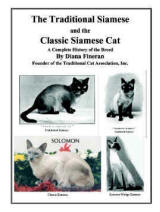|
Departments
eBook now Available!
|
Exclusive - THE book on Traditional & Classic
Siamese cats

Written by the Founder of TCA, Inc.
Tullycrine
Affordable
Web Design
|
|
|
VACCINATIONS REVISITED
Reproduced with their permission
“You have just received a postcard from your family
Veterinarian with the reminder that your dog or cat is due for the annual
vaccination or booster shot. These injections, most commonly given as modified
live vaccines (MLVs) are often several diseases combined into one shot.
Cats are vaccinated as kittens, then annually for panleukopenia (feline
distemper), viral rhinotrachetis, calici virus, feline parvo and chlamydia.
Recent research suggest that automatically giving annual,
multiple-disease booster may contribute to immune suppression and trigger the
beginning of chronic diseases such as arthritis, autoimmune disease, diabetes,
epilepsy and cancer. Many
respected, research Veterinarians say that there is no proof that yearly
vaccines are necessary or that they improve an animals/
‘s immunity. According to
“Kirk’s Current Veterinary Therapy XI”, one of the leading reference
manuals for practicing Veterinarians, annual revaccination of dogs and cats
“lacks scientific validity and verification. Almost without exception there is
no immunological requirement for revaccination.”
Think about it: We don’t
inoculate ourselves with polio, diphtheria, whooping cough, measles and mumps
vaccines every year. Why should we
be doing it to our animals?
SOME BACKGROUDN
INFORMATION: In the 19th century, Louis Pasteur claimed that
germs invaded the body and caused disease.
Meanwhile a contemporary, Antoine Beauchamp, claimed that germs were
everywhere and whenever the body’s own system was run down or
susceptible, germs would invade and diseases would develop.
Although Pasteur would later retract his germ theory and state that the
real key to disease was the “internal environment,” his original theory
became the guiding light for medicine and the basis for the development of
vaccines as well as of germ-oriented, antimicrobial therapy (antibiotics). Scientific research is now exploring Beauchamp’s original
theory and questioning whether the medical basis for vaccines may have been
built on a flawed theory, one that overlooked the immune system.
In the 1970’s, medical researchers, G. Dettman and A.
Kalokerinos, reported their work with Australian Aborigines where they proved
the immune-suppressing effects of vaccinations in Aboriginal children; they
discovered that the infant mortality rate was markedly increased with the
introduction of mass vaccinations.
Dr. Fred Klenner, an associate of Linus Pauling, was
involved in the study of the immune-stimulating effects of vitamin C. He
theorized that the rapid rise in infant leukemia was the direct result of the
introduction of mass vaccinations of children for polio.
(Dr. Jonas Salk developed the killed vaccine and Dr. Albert Sabine
developed the live vaccine). He claimed that the modified-live polio vaccine had
far-reaching, devastating effects on people and he linked the vaccine directly
to many chronic diseases, and in particular, leukemia.
INJECTION-THE
UNNATURAL ROUTE: Homeopaths and
alternative-minded Veterinarians and physicians believe that vaccines may
overwhelm the immune system. Normally,
when a body is exposed to foreign materials and diseases through the skin,
ingestion or inhalation, the body has an opportunity to react and destroy the
invader using white blood cells and producing anti-bodies to establish a true
natural immunity.
On the other hand, then an artificial disease is injected,
bypassing the body’s normal defense mechanism- its natural filter- the immune
may be weakened or overwhelmed, setting the stage for degenerative disease.
For example, every year in the U.S., it is estimated that one in 10,000
cats will get vaccine-induced fibrosarcoma, an extremely resistant, aggressive
and deadly cancer.
MINIMIZING THE SIDE
EFFECTS OF VACCINES: Do not
start the vaccine program too early. A
young immune system is more susceptible to the adverse effects of vaccines.
In addition, the antibodies found in mother’s milk will protect a
kitten or puppy for two to three months. Start vaccinations between eight and
nine weeks of age (never before six weeks).
Vaccinate only for the important infectious diseases.
By selective, depending on the area in which you live and the likelihood of
your animal being exposed to other animals. Decide with your Veterinarian which
vaccines are absolutely necessary (a core vaccination program).
Vaccinations for Lyme disease, kennel cough, FIP and feline leukemia, for
example, are not part of a core program and should be avoided.
(PLEASE NOTE: That in previous presentations in this
Newsletter by Dr. Cahill it has been determined that the vaccine for FIP
doesn’t not work and should NOT be used.)
Minimize the number of diseases per shot and the number of
shots per visit. To achieve optimal
immunity, give the least number of vaccines at any one time and give one shot
per office call. Multiple vaccinations confuse and over work the immune system.
Monovalent (single disease) vaccines are available from the manufacturers
although your Veterinarian may have to special order them.
Spread out the shots as much as possible.
Wait three weeks between visits and give the immune system a chance to
respond and recover before the next vaccine.
This will help the immune system to stay in balance and prevent burnout.
Give the vaccine in a different spot each time.
Note in your animal’s record where each vaccine is given, e.g. left
shoulder, right hind.
Use killed vaccines whenever possible and modified-live
vaccines only when there are no alternative, because modified-live vaccines can
replicate, cause a disease and be more stressful to the immune system.
There have also been reports of these viruses being shed in the urine.
Check your animal’s antibody titer before giving a
particular vaccine. After a kitten
or puppy has received the initial series, the immunity will last for varying
lengths of time-sometimes for m any years, even for the life of the
animal-depending on the animal and the health of the immune system.
For this reason, a full round of vaccinations every year is often not
necessary. With a simple blood test, your Veterinarian can determine the
antibody levels for any particular disease.
If the immunity remains strong, do not revaccinate.
Use a homeopathic remedy.
Thujaoccidentalis (Thuja 30C), a homeopathic remedy, can counteract or
minimize the adverse effects of vaccines. It
can be purchased from a health food store or a holistic Veterinarian. Follow the
directions carefully. In all cases,
start the medication after the vaccine. Do
not add homeopathic remedies to food as they will lose their effectiveness. Give
one hour before or after meals.
Sources. “Current Concepts” in The Journal of the
American Veterinay Medical Assoc, 15 August 1995, 207(4), pp. 421-425. Dodds,
W.J., “Vaccine Related Issues” in Allen Schoen and Susan Wynn, Complementary
and Alternative Vet Medicine, Principles and Practice, Mosby, St. Louis, 1998,
p. 701. Kalokerinos, A. and Dettman, G., "Second Thoughts About Disease: A
controversy and Beauchamp Revisited” in The Journal of the International
academy of Preventive Medicine, July 1977.Phillips, T. and Shultz, R., “Canina
and Feline Vaccines” in Kirk’s Current Veterinary Therapy XI, Small Animal
Practice, 1992, p. 205.
Dr. Robert Goldstein, VMD, is a holistic Veterinarian with
more than 30 years of experience. He
is an expert in immuno-augmentative therapy and pioneered cryosurgery, a
surgical technique for treating malignant tumors.
Noe C.E.O. of Bio Nutritional Diagnostics, Inc., Dr. Goldstein is
director of Northern Skies Veterinary Center in Westport, CT.
Susan Goldstein is editor of Love of Animals, Natural Care and Healing
for Dogs and Cats, V.P. and Chairman of Bio Nutritional Diagnostics, Inc. and
owner of Earth Animal. She has been
working with alternative therapies and animals for 30 years.”
TCA, INC. takes no position on this subject.
It just was a most thought-provoking article.
|
|
|

 The
Traditional Cat Association,
Inc.©1987®TM
Official Website
The
Traditional Cat Association,
Inc.©1987®TM
Official Website